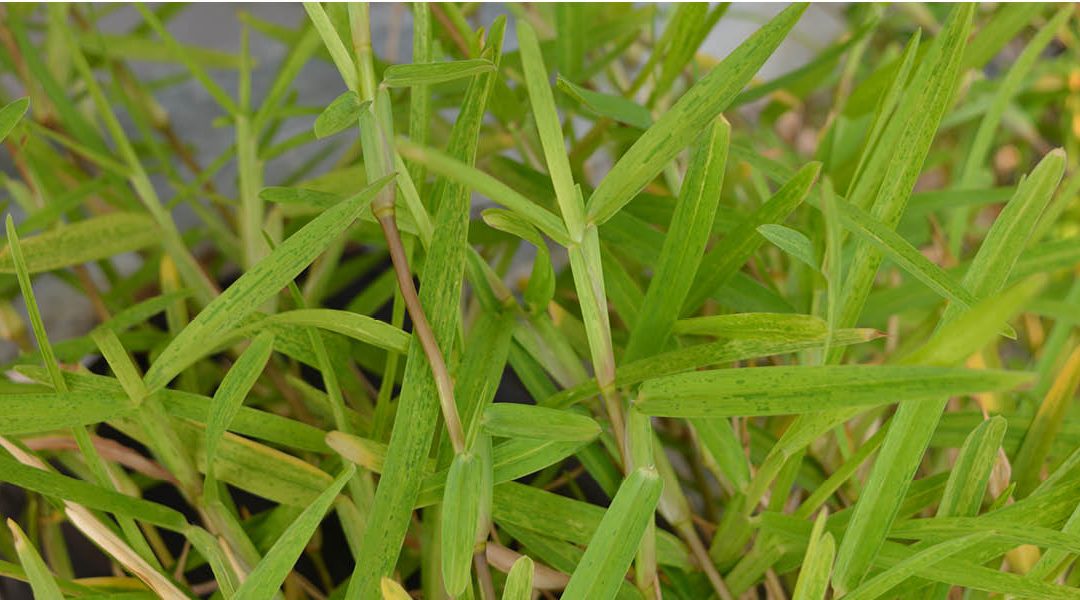Adopting best management practices has been identified as the key strategy for growers in producing turf where Buffalo Grass Yellows (BGY) is a production issue. BGY is a disease syndrome with a number of underlying causes, including crop nutrition and plant pathogens. BGY is commonly seen on turf farms with varying levels of impact on turf production but importantly, is rarely observed as a problem by the end consumer.
In response to grower feedback, particularly from farms in New South Wales, Hort Innovation funded a project in 2019 (TU19000) to investigate the causes of BGY and provide our growers with strategies to combat the disease. With work on this project recently completed, Dr Andrew Fletcher from TurfBreed recently met with A/Prof Andrew Geering to discuss its findings and key recommendations.
The project (Identification and management of mosaic viruses and secondary pathogens in Buffalo turf), conducted by A/Prof Geering and Dr Nga Tran, was a six-month long scoping study to identify possible causes of BGY and to also collect information on the success or limitations of disease management strategies being used by turf growers.
Through their work, they were able to isolate multiple viral and fungal pathogens that can contribute to yellowing in buffalo grass.
However, the most severe effects of these diseases can be largely managed through improved crop management and farm hygiene practices, and in most situations the symptoms do not persist once the turf has been installed by the end user.
Disease-causing agents
Sugarcane mosaic Virus (SCMV) and Panicum mosaic Virus (PMV) were the most commonly detected viruses associated with BGY, with most farms in NSW found to have infected stock. Fungal pathogens, however, were considered of greater importance for turf farmers in south-east QLD.

Buffalo Yellows forming tram tracks in the turf“While we did find SCMV on one farm in south-east Queensland (QLD), we were much more concerned about the impact of fungal diseases,” A/Prof Geering explained.
When BGY is caused by one of the mosaic viruses it presents differently to fungal or nutritional related symptoms. The leaves develop a stippled pattern, the leaf blades are typically narrower and internodes along the stolon are much shorter.
In the majority of situations, BGY can be managed, and the effects minimised. However, understanding the primary cause will help growers manage the risks and impacts of a potential secondary disease.
One of the viruses detected in the survey, Panicum Mosaic Virus (PMV), is one that A/Prof Geering is particularly keen to see controlled as much as possible in the industry. PMV only has a very restricted distribution as it was only identified in one variety, and only on two of the 10 farms surveyed in NSW, all in the Hawkesbury Valley.
As PMV is not yet widely distributed and does not appear to be affecting multiple buffalo grass varieties, A/Prof Geering’s advice to growers is to restrict the spread of the virus as much as possible, or even eliminate the virus from production entirely.
“There are good prospects that PMV could be eradicated from the farms where it has been found, therefore preventing the virus from becoming a more serious problem for the industry,” A/Prof Geering stated in the project’s report.
However, he also noted that complete eradication of the virus from Australia was unachievable as it has been present since at least 2008 and would have been spread to residential properties through the sale of turf.
“There is much to be learnt about the impact of SCMV on turf production, and importantly, how it could be controlled”, A/Prof Geering said.
SCMV is transmitted by migrating aphids but the use of insecticides is not recommended, as transmission usually occurs within a matter of seconds, well before the insecticides can take effect. In fact, insecticides can have the opposite effect, as before the aphids die, they can exhibit frenzied feeding behaviour and transmit the virus at an even more rapid rate. In any case, it is suspected that main method of spread of SCMV in the field is by mowing.

Another significant discovery from the project was the discovery of Bermuda Grass Latent Virus (BGLV), which was found in several cultivars of green Couch.
In the United States of America, mixed infections of this virus and SCMV causes a devastating disease of Buffalo grass caused lethal necrosis. No examples of this disease were noted in Australia but there is potential for the disease to develop in the future. To prevent such an occurrence, it is important that biosecurity measures are implemented on the farm, such as washing the mower blades with high pressure water between paddocks.
A second type of BGY was found that appeared to be caused a new species of Curvularia, which is a fungal pathogen that causes leaf spotting, as well as rotting of the roots. The root mat of turf affected by this disease was very weak, and when the grass runners were prised from the mat, the roots were blackened instead of the normal healthy white colour, and the roots easily broke.
“We noticed that this type of yellowing usually started from old turf ribbons, giving a train track pattern of yellowing across the paddock. This observation could be explained by the fungus being favoured by the build-up of thatch,” A/Prof Geering said.
A search of the older scientific literature also suggested that Curvularia epidemics are favoured by moisture, humidity and the overuse of nitrogen fertilizers.
“A common response to yellowing, in the belief that the cause is nutrient deficiency, is to apply nitrogen fertiliser,” he said.
“In cases where the yellowing is not from undernutrition, nitrogen levels can become excessive, and when coupled with constant irrigation you create an ideal environment for fungal pathogens to flourish.”
Regularly monitoring of nutrient levels, keeping accurate records of nutrient inputs, and only replacing what is being used by the turf is critical in managing the health of your crop.
Applying fertiliser in more regular, smaller applications instead of large doses less often can reduce fertiliser run-off and leeching, and reduce the build-up of fungal pathogens.
Limiting the use of nitrogen fertilisers, including chicken manure, can also mitigate the effects of BGY, as excessive nitrogen can exacerbate an existing fungal disease and will not treat the underlying cause if nutrition is not the issue.
Another long-term strategy recommended by A/Prof Geering for managing BGY and improving overall productivity is for growers to consider cultivation, crop rotation and fallowing of paddocks.
When ribbons of buffalo grass are left to regrow after harvest, they have the potential to create a refuge for the plant pathogens between crops. These strips can grow and mat together and the pathogens can return to infect the new turf crop.
Cultivation, crop rotation, or fallowing a paddock between crops can reduce or eliminate both fungal and viral infections from a paddock, however the new planting stock must also be free of disease.
“Paddocks with a mild infection can be harvested, fallowed and replanted. In more severe cases, where a disease is causing significant losses, the best course of action may be to spray out the paddock in question and start again with healthy planting stock,” A/Prof Geering explained.
“There may be a cost to the grower in the short-term, but the long-term benefit to both themselves and the industry by eliminating the disease from their property could be invaluable.”
Soil health and overall productivity can also benefit from regularly cultivating and rotating paddocks. Soil compaction, loss of soil carbon and a lack of soil structure significantly limit water and nutrient infiltration into the soil and restrict turf growth.
Breaking-up soil compaction allows water and nutrients to penetrate deeper into the profile, making it easier for plants to access a greater reserve of moisture and nutrients, and incorporating a fallow crop can boost the levels of organic carbon when ploughed back into the soil.
Looking to the future

Dr Andrew Fletcher – TurfBreed’s RnD Senior Research Scientist
Resistance to plant disease has been a focus of breeding programs over the past decades in response to major outbreaks.
Genetic variability for resistance to disease, such as SCMV, PMV or BGY, is a naturally occurring phenomenon in all turfgrass varieties, but through selective breeding, newer varieties can have greater resistance to common diseases, or a greater tolerance to an infection to reduce the impact of that disease.
Palmetto Buffalo is one such variety which has been bred specifically for resistance to SCMV, and TurfBreed is constantly looking for the latest genetics and varieties for our grower network.
As new varieties are developed, screening for resistance to common plant pathogens is essential to ensuring the long-term performance of that variety.
TurfBreed is committed to ensuring that any new varieties brought to the Australian market will be thoroughly assessed before they are released.
The critical advice for turf growers concerned about BGY is that there are multiple causes, and even when a virus is present, the symptoms of BGY are most pronounced when not managed appropriately.
Thorough cleaning and good farm hygiene will reduce the spread of any existing pathogens, and considering a break crop, or fallowing your paddocks, can also help reduce the long-term impacts of plant pathogens on your farm.
Accurate diagnosis and establishing long-term strategies to manage disease will mitigate potential risk and help increase turf quality and productivity.
If you suspect you have a plant pathogen or would like to get a proper diagnosis, you can contact A/Prof Andrew Geering or Dr Nga Tran from The University of Queensland directly to discuss you concerns and arrange for laboratory testing.
A/Prof Andrew Geering
E: a.geering@uq.edu.au
+61 7 3443 2459
Dr Nga Tran
E: n.tran3@uq.edu.au
*Dr Andrew Fletcher, Senior Research Scientist for TurfBreed, can also be contacted directly to provide advice E afletcher@turfbreed.com.au M: 0455 559 665

